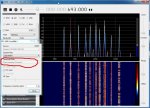thewraith2008
Member
- Joined
- Nov 22, 2016
- Messages
- 1,845
No, they use a rubidium or cesium standard. You wouldn't use FMP24 to calibrate because it's the wrong tool for the job. Use something that has better resolution like SDR# and increase the FFT resolution.
While SDR# only uses integers for the PPM value, you can use an educated guess to set the factional part and even then it's only 0.2 increments for dongles. FMP24 auto center tuning will take care of the rest if needed.
Hams have been zero beating against WWV for decades to tune radios and other things with excellent results.
Here is a video showing that exact process to tune a frequency counter. With 0.5hz accuracy.
https://www.youtube.com/watch?v=QCJ4cQGOQLI
we2aew does some great videos
Anyway using WWV was only a suggestion because it's a know standard. (3x10ˉ16)
https://www.nist.gov/pml/time-and-frequency-division/primary-standard-nist-f1
Using kalibrate against GSM. It tells me the PPM to use: (5 different channels)
CH
43 = -1.4 ppm
47 = -1.6 ppm
80 = -1.0 ppm
90 = -0.6 ppm
92 = -1.6 ppm
Test repeated 5 times. So which one above is right?
While the difference is not much, I hardly find GSM to be a calibration standard.
While SDR# only uses integers for the PPM value, you can use an educated guess to set the factional part and even then it's only 0.2 increments for dongles. FMP24 auto center tuning will take care of the rest if needed.
Hams have been zero beating against WWV for decades to tune radios and other things with excellent results.
Here is a video showing that exact process to tune a frequency counter. With 0.5hz accuracy.
https://www.youtube.com/watch?v=QCJ4cQGOQLI
we2aew does some great videos
Anyway using WWV was only a suggestion because it's a know standard. (3x10ˉ16)
https://www.nist.gov/pml/time-and-frequency-division/primary-standard-nist-f1
Using kalibrate against GSM. It tells me the PPM to use: (5 different channels)
CH
43 = -1.4 ppm
47 = -1.6 ppm
80 = -1.0 ppm
90 = -0.6 ppm
92 = -1.6 ppm
Test repeated 5 times. So which one above is right?
While the difference is not much, I hardly find GSM to be a calibration standard.


